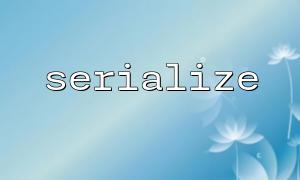In PHP, the serialize function is a common way to convert PHP variables into strings, especially for storing complex data (such as arrays, objects) into databases or files. However, if not paid attention during storage or retrieval, data corruption or inconsistency may result. This article will explain how to use PHP's serialize function to properly store data into the database and avoid possible corruption issues.
The serialize function converts PHP variables into string formats that can be stored and transferred. When you need to store an array or object into a database, PHP's serialize function is very useful because it can convert this complex data into simple strings. You can save this string in a field in the database and then use the unserialize function to restore it to the original array or object later.
For example, suppose you have an array:
$data = array("name" => "Alice", "age" => 30, "city" => "New York");
Use the serialize function to convert it into a string:
$serializedData = serialize($data);
echo $serializedData;
The output will be a string representation, similar to:
a:3:{s:4:"name";s:5:"Alice";s:3:"age";i:30;s:4:"city";s:8:"New York";}
After using the serialize function to convert the data into a string, you can store it in the database. Suppose you have a simple database table called users that contains a preferences field to store user preferences. You can use the serialize function to convert array data into strings and insert them into the database.
// Suppose you have connected to the database
$data = array("theme" => "dark", "language" => "en");
$serializedData = serialize($data);
// Insert data using database query
$sql = "INSERT INTO users (preferences) VALUES (:preferences)";
$stmt = $pdo->prepare($sql);
$stmt->execute(['preferences' => $serializedData]);
In this example, the user's preferences are stored in the preferences field of the database as a serialized string.
When you retrieve stored serialized data from the database, use the unserialize function to restore it to the original PHP data type. Suppose you want to get the user's preferences and restore it to an array:
// Retrieve serialized strings from the database
$sql = "SELECT preferences FROM users WHERE id = :id";
$stmt = $pdo->prepare($sql);
$stmt->execute(['id' => 1]);
$row = $stmt->fetch();
// use unserialize Restore data
$preferences = unserialize($row['preferences']);
print_r($preferences);
At this time, $preferences will be an associative array:
Array
(
[theme] => dark
[language] => en
)
When using serialize and unserialize functions, you need to be particularly careful about potential risks, especially when the data is retrieved from the database:
Make sure that the character sets of databases and tables are set correctly, and UTF-8 character sets are usually used to avoid character encoding issues. Otherwise, the serialized string may cause data corruption due to inconsistent character encoding.
When performing database operations, never directly embed the data entered by the user into SQL queries. Always use prepared statements to avoid SQL injection attacks.
When using the unserialize function, you may encounter deserialization failure. At this time, you can use the @ operator to suppress errors and check whether the deserialization result is false , and take appropriate error handling measures.
$preferences = @unserialize($row['preferences']);
if ($preferences === false) {
// Deserialization failed,Handling errors
echo "Failed to unserialize data.";
}
Although the serialize function is very powerful, in some cases you can also consider using json_encode and json_decode functions instead. The JSON format is usually easier to interact with other languages and platforms and does not rely on PHP-specific serialization mechanisms when processed.
// use json_encode and json_decode
$data = array("theme" => "dark", "language" => "en");
$jsonData = json_encode($data);
// Store to database
$sql = "INSERT INTO users (preferences) VALUES (:preferences)";
$stmt = $pdo->prepare($sql);
$stmt->execute(['preferences' => $jsonData]);
// Retrieve and restore from the database
$sql = "SELECT preferences FROM users WHERE id = :id";
$stmt = $pdo->prepare($sql);
$stmt->execute(['id' => 1]);
$row = $stmt->fetch();
$preferences = json_decode($row['preferences'], true);
print_r($preferences);
JSON has wider compatibility than serialize , especially when data exchange with external systems is required.
Summarize
Using PHP's serialize function can easily store complex data into a database, but when actually operating, you still need to pay attention to prevent data corruption. Ensure the correctness of the character set, use preprocessing statements to prevent SQL injection, and handle deserialization errors. Also, consider using json_encode and json_decode as alternatives to serialization, especially when interacting with other languages or platforms.















